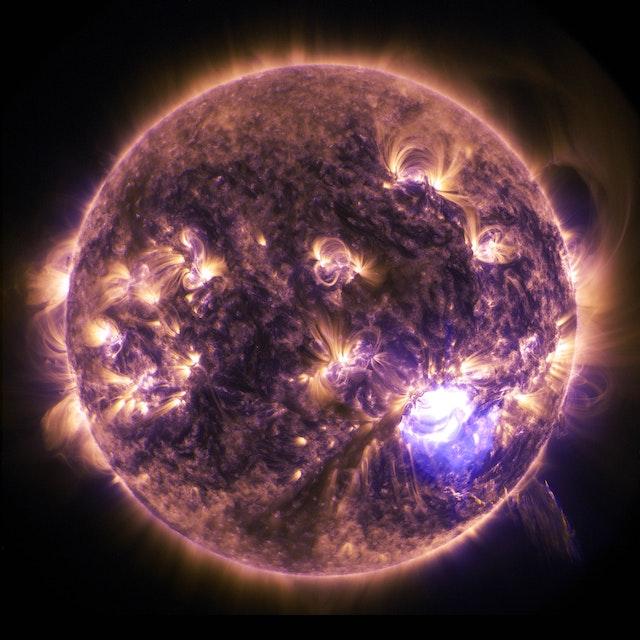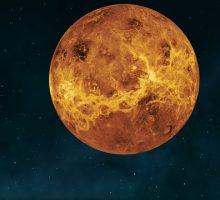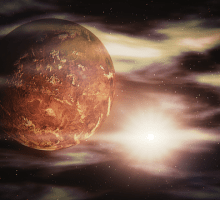- Exploring Venus: A Close-Up Look at Our Nearest Planetary Neighbor
- Venus: The Hottest Planet in Our Solar System
- Uncovering the Mysteries of Venus: What We Know So Far
- Surviving on Venus: The Challenges of Colonizing Our Sister Planet
- Venus’s Atmosphere: A Harsh Environment with Lessons for Earth
- Venus’s Volcanoes: A Window into the Planet’s Violent Past
- The Venus Transit: A Rare Astronomical Event with Scientific Significance
- Venus and Earth: A Tale of Two Very Different Planets
- Venus’s Retrograde Rotation: A Unique Feature of Our Planetary Neighbor
- The Search for Life on Venus: Could Our Sister Planet Harbor Living Organisms?
Exploring Venus: Our Closest Planetary Neighbor Up Close
Venus, the second planet from the sun and the closest one to Earth, has always been a fascinating subject of study for scientists and astronomers alike. As the hottest planet in our solar system, Venus presents many unique challenges and opportunities for exploration.
In recent years, there have been several missions to Venus, each aimed at shedding more light on this enigmatic planet. From the Soviet Venera missions of the 1970s and 1980s to the recent Parker Solar Probe and BepiColombo missions, there has been a steady stream of data and insights into the workings of Venus.
One of the most significant recent missions was NASA’s Magellan spacecraft, which orbited Venus from 1990 to 1994. Using radar, Magellan mapped nearly the entire surface of the planet and provided scientists with valuable information about its geology and topography.
Thanks to these missions, we now know that Venus is a rocky, terrestrial planet with a thick atmosphere that consists mainly of carbon dioxide. The planet’s surface is dominated by vast plains, mountains, and volcanoes, some of which are still active today.
Despite the extreme conditions on Venus, scientists are interested in exploring the planet further. The potential rewards are many: studying Venus could help us understand how planets form and evolve, and provide insights into the formation and evolution of our own planet.
In the coming years, there are several planned missions to Venus, including the European Space Agency’s EnVision mission and NASA’s VERITAS mission. These missions will focus on mapping Venus’s surface and studying its geology and atmosphere in more detail.
Overall, exploring Venus is an exciting and ongoing journey, one that promises to yield valuable insights into the workings of our solar system and the universe at large.
Venus: Our Solar System’s Hottest Planet
When we think of extreme heat, our minds might jump to the deserts of the Middle East or the Australian Outback. But compared to Venus, these hotspots are downright chilly. Venus is the hottest planet in our solar system, with surface temperatures that can reach a scorching 864 degrees Fahrenheit (462 degrees Celsius).
What makes Venus so hot? There are several factors at play. First and foremost is the planet’s proximity to the sun. Venus orbits the sun at an average distance of about 67 million miles (108 million kilometers), which means it receives about twice as much solar radiation as Earth.
But that’s only part of the story. Venus also has a thick atmosphere that traps heat and creates a runaway greenhouse effect. The planet’s atmosphere is primarily composed of carbon dioxide, which absorbs and traps heat from the sun. This causes the planet’s surface temperature to soar, creating a hellish environment that’s completely inhospitable to life as we know it.
Despite these extreme conditions, scientists are still interested in studying Venus. The planet has many mysteries that we have yet to unravel, including the nature of its dense, cloudy atmosphere and the mechanisms that drive its intense volcanic activity.
To that end, there are several upcoming missions to Venus, including the European Space Agency’s EnVision mission and NASA’s VERITAS mission. These missions will use advanced instruments to study the planet’s surface, atmosphere, and geology in greater detail than ever before.
As we continue to explore Venus, we will undoubtedly gain a better understanding of our solar system and the complex processes that shape our world and others like it. While Venus may not be a place we’d want to visit anytime soon, it remains a fascinating subject of study for scientists and space enthusiasts alike.
Uncovering the Mysteries of Venus: What We Have Discovered So Far
Venus, our nearest planetary neighbor, has long been a subject of fascination for astronomers and space enthusiasts alike. Despite being so close to us, there is still much we do not know about this enigmatic planet. In recent years, however, scientists have made great strides in uncovering some of Venus’s mysteries.
One of the most significant discoveries has been the realization that Venus was once a much more hospitable place than it is today. Recent research suggests that the planet may have had a shallow ocean and a mild climate billions of years ago. This has led some scientists to speculate that Venus might have once been home to microbial life.
Another area of intense study has been Venus’s atmosphere. The planet’s thick, cloudy atmosphere has long made it difficult to study, but recent missions have provided us with valuable insights. For example, we now know that Venus’s atmosphere is primarily composed of carbon dioxide, with trace amounts of other gases like nitrogen and sulfur dioxide. We’ve also discovered that the planet’s atmosphere rotates much faster than its surface, a phenomenon known as superrotation.
One of the most intriguing mysteries surrounding Venus is the nature of its surface. For many years, scientists believed that Venus was a geologically inactive planet. However, more recent research has suggested that the planet is still tectonically active and may even have active volcanoes.
To help solve these mysteries, several missions to Venus are currently in the works. These missions will use a variety of instruments to study Venus’s surface, atmosphere, and geology in greater detail than ever before.
As we continue to learn more about Venus, we will undoubtedly uncover new mysteries and questions. But one thing is certain: the more we learn about our planetary neighbor, the more we will understand about the complex processes that shape our solar system and the universe beyond.
Surviving on Venus: The Challenges of Establishing a Colony on Our Sister Planet
As we continue to explore our solar system, the idea of colonizing other planets has become increasingly attractive. Mars has long been a target for potential colonization, but in recent years, there has been growing interest in the idea of establishing a colony on Venus. However, this would be no easy feat, as Venus presents a host of unique challenges that would need to be overcome.
One of the biggest challenges of colonizing Venus is its extreme environment. As previously mentioned, the planet’s surface temperatures can reach up to 864 degrees Fahrenheit (462 degrees Celsius), which is hot enough to melt lead. Additionally, Venus’s atmosphere is incredibly thick and acidic, making it a hostile environment for humans to live in.
To overcome these challenges, any Venus colonization mission would require advanced technology and innovative solutions. One potential idea is to establish floating cities in Venus’s atmosphere, where temperatures and pressures are more moderate. Another approach is to use robots and other remotely controlled devices to explore and interact with the planet’s surface, rather than sending humans directly.
Another major challenge of colonizing Venus is the planet’s lack of water. Unlike Mars, which has significant quantities of water ice, Venus is almost completely dry. Any colony would need to develop advanced systems for extracting and recycling water in order to survive.
Finally, there is the challenge of building a self-sustaining colony that can operate independently of Earth. This would require developing technologies for growing food, generating energy, and creating a closed-loop ecosystem that can support human life.
Despite these challenges, the idea of colonizing Venus remains an intriguing possibility. As we continue to develop new technologies and push the boundaries of what’s possible, we may one day be able to establish a thriving colony on our sister planet. In doing so, we would not only expand our presence in the solar system but also gain a deeper understanding of the complex processes that shape the universe around us.
Venus’s Atmosphere: A Harsh Environment with Lessons for Earth
Venus’s atmosphere is one of the most inhospitable environments in our solar system. The planet’s thick clouds of sulfuric acid and carbon dioxide create a runaway greenhouse effect, trapping heat and creating surface temperatures that can reach up to 864 degrees Fahrenheit (462 degrees Celsius). However, despite its harshness, Venus’s atmosphere provides us with valuable lessons for understanding the behavior of our own planet.
One of the most important lessons we can learn from Venus’s atmosphere is the danger of unchecked greenhouse gas emissions. While Venus’s extreme greenhouse effect is a natural phenomenon, it serves as a cautionary tale for what can happen when greenhouse gas concentrations get out of control. Earth is currently experiencing a similar buildup of greenhouse gases, primarily carbon dioxide, which is contributing to global warming and climate change.
By studying Venus’s atmosphere, we can gain a better understanding of how the Earth’s climate system works and how it might respond to changing conditions. This includes studying the role of clouds and aerosols in reflecting sunlight back into space, as well as the impact of atmospheric chemistry on climate.
Another valuable lesson we can learn from Venus’s atmosphere is the importance of planetary exploration. Studying other planets, including Venus, allows us to gain new perspectives on our own planet and its place in the universe. This includes developing new technologies for remote sensing and exploration, as well as advancing our understanding of the processes that shape the solar system as a whole.
Finally, studying Venus’s atmosphere can also provide insights into the potential for habitable environments on other planets. While Venus itself may not be habitable, the techniques and technologies developed for studying its atmosphere could be applied to other planets, including those in the habitable zone of other stars.
Venus’s Volcanoes: A Window into the Planet’s Violent Past
Venus is a planet with a violent and tumultuous history, and one of the key features that provides us with a glimpse into that history is its vast network of volcanoes. Unlike Earth’s volcanoes, which are primarily concentrated along tectonic plate boundaries, Venus’s volcanoes are scattered across its surface, with some of them towering more than 8 miles (13 kilometers) high. By studying these volcanoes, we can gain a better understanding of the planet’s past and the forces that have shaped it.
One of the most interesting things about Venus’s volcanoes is their sheer size. The largest volcano on Venus, Maat Mons, is nearly 6 miles (9.5 kilometers) high and has a base that is more than 600 miles (1,000 kilometers) wide. By comparison, the largest volcano on Earth, Mauna Loa in Hawaii, is only about 4 miles (6.4 kilometers) high and has a base that is less than 100 miles (160 kilometers) wide.
Another unique feature of Venus’s volcanoes is their composition. While most of Earth’s volcanoes are formed from basaltic lava, Venus’s volcanoes are primarily composed of a type of rock called komatiite. This type of rock is extremely rare on Earth and is believed to have formed when the planet was still in its infancy, more than 4 billion years ago.
By studying the composition of Venus’s volcanoes, scientists can gain insights into the planet’s early history and how it evolved over time. This includes studying the presence of isotopes such as lead and sulfur, which can provide clues about the age and origin of the rocks.
Finally, the study of Venus’s volcanoes can also provide insights into the potential for habitable environments on other planets. While Venus itself may not be habitable, the presence of volcanoes suggests the possibility of subsurface reservoirs of water and other materials that could support life. This includes studying the potential for volcanic activity on other planets, including those in the habitable zone of other stars.
The Venus Transit: A Rare Astronomical Event with Scientific Significance
The Venus transit is a rare astronomical event that occurs when the planet Venus passes directly between the Earth and the Sun. This event is only visible from certain locations on Earth and typically occurs in pairs, separated by eight years, with more than a century between each pair. The last Venus transit occurred in 2012, and the next one is not expected until 2117. While this event is visually stunning, it also has scientific significance and provides us with valuable insights into the workings of our solar system.
One of the key scientific insights we gain from the Venus transit is the ability to measure the distance between the Earth and the Sun with greater precision. By observing the transit from multiple locations on Earth and timing the exact moment when Venus passes across the Sun, astronomers can use the principles of parallax to calculate the distance between the Earth and the Sun. This distance, known as the astronomical unit (AU), is a fundamental measurement in astronomy and is used to calculate distances throughout the solar system.
Another important scientific insight we gain from the Venus transit is the ability to study the atmosphere of Venus in greater detail. When Venus passes in front of the Sun, the planet’s atmosphere causes a small amount of sunlight to pass through it, producing a faint halo of light around the planet’s silhouette. By studying this halo of light, scientists can learn more about the composition and structure of Venus’s atmosphere, including the presence of clouds, gases, and other materials.
The Venus transit also provides us with an opportunity to study the properties of the Sun itself. During the transit, Venus blocks a small fraction of the Sun’s light, which can be used to study the Sun’s brightness and the structure of its atmosphere. This includes studying the presence of sunspots, which are areas of intense magnetic activity on the Sun’s surface, as well as the presence of prominences and other features in the Sun’s outer atmosphere.
Finally, the Venus transit is a reminder of the beauty and complexity of our solar system. While we often take our place in the universe for granted, events like the Venus transit remind us of the intricate dance of the planets and the incredible forces that shape our world. By continuing to study events like the Venus transit, we can gain a deeper appreciation for the universe around us and the mysteries that still await discovery.
Venus and Earth: A Tale of Two Very Different Planets
Venus and Earth are often referred to as sister planets due to their similar size, mass, and composition. However, despite their similarities, the two planets are also vastly different in many ways. In this article, we will explore the similarities and differences between Venus and Earth and examine what these differences can teach us about the formation and evolution of planets.
One of the most striking differences between Venus and Earth is their atmospheres. While Earth’s atmosphere is composed mainly of nitrogen and oxygen, Venus’s atmosphere is mostly made up of carbon dioxide. In fact, Venus has the densest atmosphere of all the terrestrial planets in our solar system. The high concentration of carbon dioxide on Venus creates a strong greenhouse effect, which leads to surface temperatures that can reach up to 864 degrees Fahrenheit (462 degrees Celsius). This makes Venus the hottest planet in our solar system, even though it is not the closest planet to the Sun.
Another major difference between Venus and Earth is their surface features. Earth has a variety of surface features, including mountains, valleys, oceans, and continents. Venus, on the other hand, is covered in a thick layer of clouds that obscures its surface from view. However, radar mapping has revealed that Venus has a complex and varied surface, including vast plains, highlands, and hundreds of volcanoes. In fact, Venus has more volcanoes than any other planet in our solar system.
The differences in the atmospheres and surface features of Venus and Earth are due to a number of factors, including their distance from the Sun, their size and mass, and their geological histories. While Earth is a dynamic planet with a constantly changing surface and atmosphere, Venus has a much slower geological activity, and its surface is largely unchanged over millions of years.
Despite their differences, studying Venus and Earth side by side can provide us with valuable insights into the formation and evolution of planets. By understanding the factors that have shaped Venus and Earth into the planets they are today, we can gain a better understanding of how other planets in our solar system and beyond may have formed and evolved.
Venus’s Retrograde Rotation: A Unique Feature of Our Planetary Neighbor
Venus is a fascinating planet that has captured the attention of scientists and stargazers for centuries. One of the most unique features of Venus is its retrograde rotation, which means that the planet rotates on its axis in the opposite direction to most other planets in our solar system. In this article, we will explore why Venus rotates in this way and what impact it has on the planet.
Firstly, let’s clarify what we mean by retrograde rotation. Most planets in our solar system, including Earth, rotate on their axis in a counterclockwise direction when viewed from above the North Pole. However, Venus rotates in the opposite direction, which is known as a retrograde rotation.
Scientists believe that Venus’s retrograde rotation is the result of a collision with a large object in the early days of the solar system. This collision would have caused the planet to start spinning in the opposite direction to its original rotation. Over time, this retrograde rotation has become locked in, meaning that Venus will continue to rotate in this direction for millions of years to come.
Venus’s retrograde rotation has a number of interesting consequences. One of the most noticeable is the length of a day on Venus. Because the planet rotates in the opposite direction to most other planets, a day on Venus is actually longer than its year. It takes Venus 243 Earth days to complete one rotation on its axis, but only 225 Earth days to orbit the Sun.
Another consequence of Venus’s retrograde rotation is the unique pattern of its magnetic field. Most planets in our solar system, including Earth, have a magnetic field that is aligned with their axis of rotation. However, Venus’s magnetic field is tilted at a 177-degree angle to its axis of rotation. This means that the magnetic field of Venus interacts with the solar wind in a very different way to Earth’s magnetic field, which can have implications for space weather and the planet’s ability to retain its atmosphere.
The Search for Life on Venus: Could Our Sister Planet Harbor Living Organisms?
For many years, scientists have been searching for signs of life beyond Earth. While Mars has been the focus of much attention in this regard, another planet in our solar system has recently come into focus as a possible home for life: Venus. In this article, we will explore the possibility of life on Venus and the ongoing search for evidence of living organisms on our sister planet.
At first glance, Venus may seem like an unlikely candidate for life. Its surface temperature is hot enough to melt lead, and its atmosphere is thick with carbon dioxide and sulfuric acid. However, recent research has suggested that there may be conditions on Venus that could support life in the planet’s upper atmosphere.
One of the key indicators of life on Venus is the presence of phosphine gas in the planet’s atmosphere. Phosphine is a gas that is produced by living organisms here on Earth, and its presence on Venus could suggest the existence of life there as well. In 2020, a study published in the journal Nature Astronomy reported the detection of phosphine in Venus’s atmosphere, sparking renewed interest in the search for life on our sister planet.
While the discovery of phosphine on Venus is intriguing, it is not yet clear whether it is a definitive sign of life. The gas could be produced by non-biological processes, and there is much work to be done to confirm the presence of living organisms on the planet.
To further explore the possibility of life on Venus, NASA and other space agencies are planning a number of missions to the planet in the coming years. These missions will include orbiters, landers, and even balloons that will study the planet’s atmosphere and search for signs of life.
Conclusion
In conclusion, the exploration of Venus has provided scientists with a wealth of knowledge about our planetary neighbor. From its extreme environment and unique features to the possibility of life, Venus continues to captivate and intrigue us. While much is still unknown about this mysterious planet, ongoing research and future missions offer the promise of uncovering even more secrets and expanding our understanding of the universe. As we continue to explore the wonders of Venus, we are reminded of the vastness and complexity of the cosmos and our place in it.
ScitechVenture YouTube Channel












